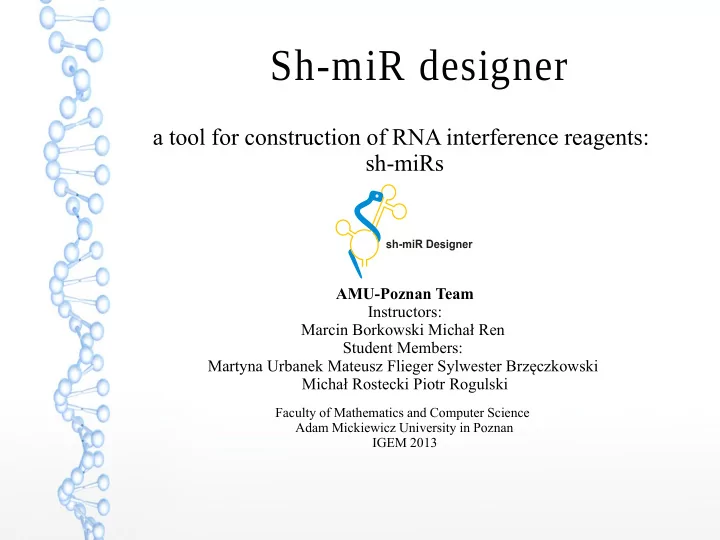

S h - m i R d e s i g n e r a tool for construction of RNA interference reagents: sh-miRs AMU-Poznan Team Instructors: Marcin Borkowski Michał Ren Student Members: Martyna Urbanek Mateusz Flieger Sylwester Brzeczkowski Michał Rostecki Piotr Rogulski Faculty of Mathematics and Computer Science Adam Mickiewicz University in Poznan IGEM 2013
RNAi reagents (pri-miRNA → sh-miR)
Cons E a s y t o u s e ● Combines several functionalities ● Fastens sh-miR designing ● Using several pri-miRNA flanking sequences ●
Input A s i n p u t i t i s p o s s i b l e t o u s e o n e s t r a n d o f s i R N A o r b o t h s t r a n d s o f s i R N A s e p a r a t e d b y a s p a c e . Sequences have to be in 5’-3’ orientation and be at least 80% complementary. Our function checks: Whether the sequence has only actguACTGU letters Whether only one or two sequences are entered Whether a single sequence is 19-21 long If two strands given whether sequences are complementary in at least 80% Function changes: Function cuts ‘tt’ and ‘uu’ ends, lowers all letters and changes all ‘u’ to ‘t’
Complementary check It is checked whether the two strands are complementary and whether they are in 0-0 position: AACCTTGGAACCTTGG TTGGAACCTTGGAACC or are shifted: e.g. +2, -2 AACCTTGGAACCTT GG TT GGAACCTTGGAACC
Insert siRNA sequence into flanking sequences The function takes all flanking sequences from our database (in sh-miR designer v1.0 there are five pri-miRNA flanking sequences). Database structure: id SERIAL PRIMARY KEY, name varchar(10) NOT NULL, flanks3_s varchar(80) NOT NULL, flanks3_a varchar(80) NOT NULL, flanks5_s varchar(80) NOT NULL, flanks5_a varchar(80) NOT NULL, loop_s varchar(30) NOT NULL, loop_a varchar(30) NOT NULL, miRNA_s varchar(30) NOT NULL, miRNA_a varchar(30) NOT NULL, miRNA_length integer NOT NULL, miRNA_min integer NOT NULL, miRNA_max integer NOT NULL, miRNA_end_5 integer NOT NULL, miRNA_end_3 integer NOT NULL, structure varchar(200) NOT NULL, homogeneity integer NOT NULL, miRBase_link varchar(200) NOT NULL
miRNA sequences used
Structure check First the function generates .ss files with use of mfold program. Example of an .ss file fragment: Then the file is parsed to contain only the first and last column. The numbers assigned to the nucleotides have to be verified, because flanking sequences can be shortened or extended during insertion. Moreover, the length of the siRNA insert can differ from the natural one. The modified file is compared with the structure file obtained from the .ss file for pri-miRNA. The third column represents scores if the structure is retained in the position Example of a file fragment with scores: The function scores the structure and returns a point value ranged from 0 to 100.
Final scoring and Output The final scoring includes: points for structure (ranged 0-100) points for fanking sequences homogeneity (ranged 0-15) additional points if the frst nucleotides of the siRNA and miRNA inserts are equal (0,4 or 10 points) As output the user gets 3 the best results with a pdf file showing 2D structure.
sh-miR designer 2.0 1. Providing only the transcript name (or the number from NCBI database) will be enough to construct the desired sh-miR. It will be possible thanks to the included blast-like algorithm which will search through the transcript sequence to fnd the appropriate siRNA sequence. 2. pri-miRNA database will be expanded 3. Prepare DNA constructs ready to clone into a couple of widely used plasmid vectors (e.g. pCDH-MCS-EF1-GFP) with added sequences containing restriction fragments to digest by widely used restriction enzymes. 4. Immunostimulatory motifs are present in the prepared sh-miR molecule. 5. To improve the specifcity of designed reagents, we will be testing off-target effects using a blast tool to search through the reference transcript sequences from the NCBI database.
Live presentation – – – Thank you for your attention! –
Recommend
More recommend